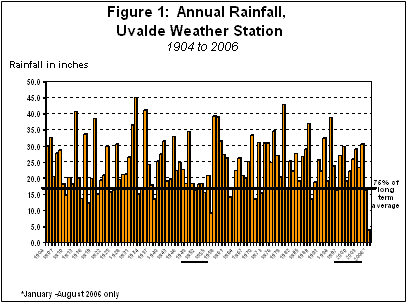Click here for the Acrobat version of this publication.
AG-ECO NEWS
Vol. 22, Issue 29, September 13, 2006
Jose G. Peña
Extension Economist-Management
Driest Period On Record; Comparing The 50’s To The 2000’s Recovery Will Be Slow And Require Special Planning
Rains and the cool weather this past week were a welcome relief from the hot dry summer, but the region remains very dry. It will take a major sequence of above average rainfall to recover from the continuing drought. The last 17-month period, from April ‘05 through August ‘06, was the driest period on record. As measured in the weather station in Uvalde, Texas, only about fourteen inches of total rainfall were received, compared to a long term average of 39.9 inches for the same period,
How does this drought compare to the drought of record of the ‘50s? A quick comparison (see figure 1) would indicate that drought of the 50’s extended for several years. Weathermen define a true drought as a period when 75% or less of the long term average yearly rainfall has been received. A review of figure 1 indicates that the drought of the 50’s began in 1948, hovered at close to the 75% classic definition of a drought for four years (1950-1954), skipped 1955 and resumed in 1956. That year was the lowest rainfall year of the series with only 9.29 inches of annual rain. In comparison, the current drought began in 2005.

The 50’s vs. the 2000’s
A comparison of the drought of the 50’s and the current drought can be made by comparing rainfall received, by month, as a percent deviation from the long term average received (see figure 2). The drought of the 50’s hovered at very close to the classic definition of a drought for several years with an average deficit of 35 percent over 84 months, from January ‘50 through December ‘56 (see 2a). In comparison, the average deficit for the current drought is only six percent over an 80 month period, from January ‘00 through August ‘06 (see 2b).

But, comparing the worst period of each drought, rainfall received during the sixteen month period, from September ‘55 through December ‘56 averaged 60 percent below the long term average compared to an average deficit of 64 percent during the 17 month period from April ‘05 through August ‘06. Yes, that is about 64 percent less rainfall than the average amount which has created the ecological environment which is dependent on that rain. In addition, the drastic reduction is over an extended monthly period, covering at least three growth cycles (spring, fall, spring) and is entering a 4th growth cycle.
In the final analysis, the real effect of any drought is its influence on vegetation and the vegetation’s capability to recover. To recover, the vegetation’s seed or rootstock must survive a drought. Seed/rootstock must be protected during periods of reduced rainfall, such as severely reducing grazing pressure. Recovery also requires abundant and timely rainfall. Abundant, above average rainfall during the five years (1957-1961) after the drought of the 50’s (see figure 1) helped ranges to recover. In addition to continued reduced stocking rates, we will need similar above average rainfall for several years to recover from the current drought. Even then it may be difficult to recover. Rain forecasts appear pessimistic in the short term.
In terms of the current drought, rainfall just prior to this past 17 month period (Fall/Winter ‘04-‘05) was above average and may have encouraged over-grazing into the summer ‘05, leaving very little vegetative cover into 2006. Field termites destroyed a lot of the vegetative cover. Record high temperatures this past summer on bare soil probably severely weakened the rootstock. It may be difficult to recover, even if we have above average rainfall. Ranchers realize the severe absence of forage.
After several livestock liquidations during the last several months, especially in southwest Texas, major livestock movement is underway again. Remaining cattle are being moved out of Texas, to Colorado and to eastern parts of the U.S. where some forage is available. The expansion of the U.S. cattle herd as indicated in USDA’s July 12, 2006 mid-year U.S. cattle inventory report may be significantly delayed.
